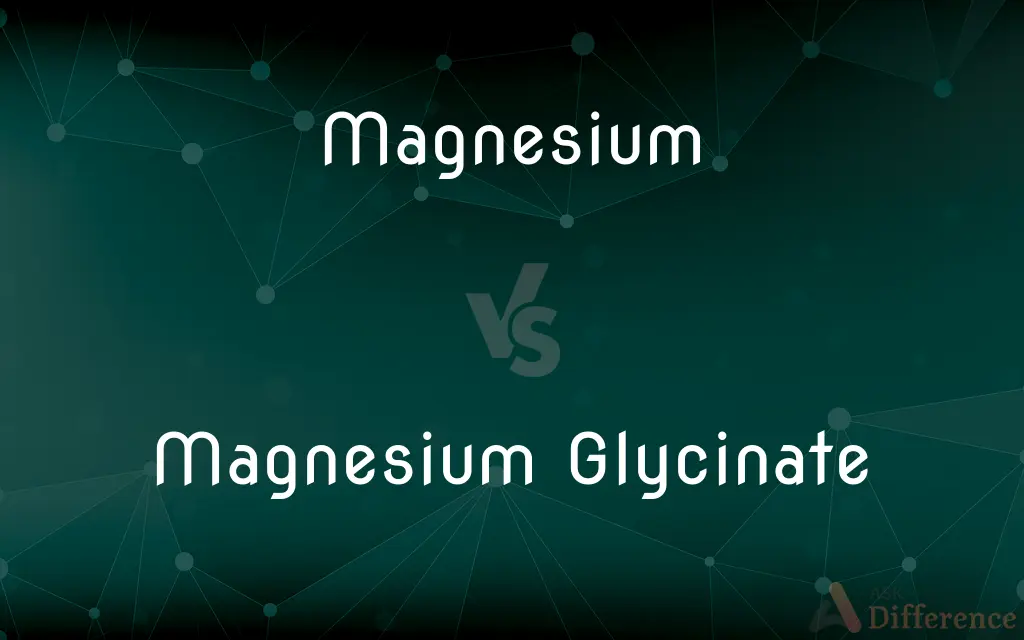Magnesium vs. Magnesium Glycinate — What's the Difference?
By Tayyaba Rehman — Published on November 28, 2023
Magnesium is a chemical element (Mg). Magnesium Glycinate is a magnesium salt bound with glycine, often used as a supplement for better absorption. Different forms, same element.

Difference Between Magnesium and Magnesium Glycinate
Table of Contents
ADVERTISEMENT
Key Differences
Magnesium is a chemical element symbolized as Mg and holds an atomic number 12. Magnesium Glycinate, on the other hand, is a combination of magnesium with glycine (an amino acid) and is frequently utilized in supplements due to its high bioavailability.
Magnesium is recognized for its role in various physiological functions and is naturally present in many foods. Magnesium Glycinate is particularly praised among magnesium supplements due to its gentle nature on the digestive system and its ability to be well-absorbed.
Magnesium, in its elemental form, is a shiny gray solid and has common usage in such products like airplanes and missiles due to its low density and ability to withstand high temperatures. Magnesium Glycinate, in contrast, is primarily encountered in a supplement form and is not used in industrial applications.
Magnesium can be found in abundance in the Earth's crust and is the eighth most abundant element in the universe by mass. Magnesium Glycinate, however, is synthesized for specific use, mainly in dietary supplements to ensure an adequate intake of magnesium.
Magnesium is essential in human biology, involved in over 600 enzymatic reactions in the body. Magnesium Glycinate provides a means to supplement magnesium intake, often chosen for its higher bioavailability and lower gastrointestinal side effects.
ADVERTISEMENT
Comparison Chart
Definition
Chemical element.
Magnesium bound with glycine.
Use in Industry
Used in aerospace, etc.
Primarily used in supplements.
Occurrence
Found naturally in the earth.
Synthesized for specific use.
Biological Role
Involved in enzymatic reactions
Used for supplementation.
Chemical Structure
Atomic structure.
Molecular compound.
Compare with Definitions
Magnesium
Magnesium plays a crucial role in human physiology.
Magnesium is essential for muscle and nerve function in the human body.
Magnesium Glycinate
Magnesium Glycinate is used in dietary supplements.
People often choose Magnesium Glycinate to avoid digestive issues.
Magnesium
Magnesium is present in various minerals.
Magnesium is a constituent of the mineral dolomite.
Magnesium Glycinate
Magnesium Glycinate helps in providing magnesium to the body.
To combat magnesium deficiency, doctors might recommend Magnesium Glycinate.
Magnesium
Magnesium is a silver-white metallic element.
Magnesium is lightweight and has extensive uses in the aerospace industry.
Magnesium Glycinate
Magnesium Glycinate assists in supporting bodily functions.
Magnesium Glycinate can support muscle and nerve functions in the body.
Magnesium
Magnesium reacts with oxygen to form magnesium oxide.
When magnesium burns, it forms a bright white light.
Magnesium Glycinate
Magnesium Glycinate is a magnesium salt bonded with glycine.
Magnesium Glycinate is praised for its high bioavailability.
Magnesium
Magnesium is utilized in the production of steel.
Magnesium is added to steel to improve its strength and durability.
Magnesium Glycinate
Magnesium Glycinate is known for its gentle impact on the stomach.
Magnesium Glycinate is preferable for those with sensitive stomachs.
Magnesium
A light, silvery-white, moderately hard metallic element that in ribbon or powder form burns with a brilliant white flame. Obtained chiefly from magnesite, dolomite, and bodies of salt water, it is used in structural alloys, pyrotechnics, flash photography, and incendiary bombs. Atomic number 12; atomic weight 24.305; melting point 650°C; boiling point 1,090°C; specific gravity 1.738 (at 20°C); valence 2. See Periodic Table.
Magnesium
The chemical element (symbol Mg) with an atomic number of 12. It is a light, easily flammable, silvery-white alkaline earth metal.
Magnesium
A light silver-white metallic element of atomic number 12, malleable and ductile, quite permanent in dry air but tarnishing in moist air. It burns, forming (the oxide) magnesia, with the production of a blinding light (the so-called magnesium light) which is used in signaling, in pyrotechny, or in photography where a strong actinic illuminant is required. Its compounds occur abundantly, as in dolomite, talc, meerschaum, etc. Symbol Mg. Atomic weight, 24.305. Specific gravity, 1.75.
Magnesium
A light silver-white ductile bivalent metallic element; in pure form it burns with brilliant white flame; occurs naturally only in combination (as in magnesite and dolomite and carnallite and spinel and olivine)
Common Curiosities
What is Magnesium?
Magnesium is a chemical element with the symbol Mg and atomic number 12.
Why is Magnesium Glycinate preferred as a supplement?
Magnesium Glycinate is preferred due to its high absorption rate and being gentle on the stomach.
What is the primary use of Magnesium Glycinate?
Magnesium Glycinate is primarily used as a dietary supplement due to its high bioavailability.
Where is Magnesium found naturally?
Magnesium is found in the Earth's crust and is also present in many foods, such as nuts, seeds, and leafy green vegetables.
Is Magnesium essential for the human body?
Yes, magnesium is crucial as it plays a role in over 600 enzymatic reactions in the body.
How is Magnesium Glycinate made?
Magnesium Glycinate is synthesized by binding magnesium with the amino acid glycine.
What is Magnesium Glycinate?
Magnesium Glycinate is a magnesium salt where magnesium is bonded with the amino acid glycine.
What happens when Magnesium reacts with oxygen?
Magnesium burns with a bright white light and forms magnesium oxide when it reacts with oxygen.
Why might someone be recommended Magnesium Glycinate?
Magnesium Glycinate might be recommended for its ability to supplement magnesium without causing gastrointestinal distress.
How is Magnesium utilized in the industry?
Magnesium is widely used in industries such as aerospace due to its low density and resistance to high temperatures.
Can Magnesium Glycinate be used to treat magnesium deficiency?
Yes, Magnesium Glycinate is often recommended to address magnesium deficiency due to its bioavailability.
Is Magnesium present in the human body?
Yes, magnesium is present and is fundamentally vital for numerous physiological functions.
Can Magnesium be found in food?
Yes, magnesium can be found in foods like spinach, seeds, and whole grains.
Is Magnesium Glycinate natural?
Magnesium Glycinate is not found naturally; it is synthesized for use in supplements.
Share Your Discovery

Previous Comparison
PSD vs. PNG
Next Comparison
Primary Memory vs. Secondary MemoryAuthor Spotlight
Written by
Tayyaba RehmanTayyaba Rehman is a distinguished writer, currently serving as a primary contributor to askdifference.com. As a researcher in semantics and etymology, Tayyaba's passion for the complexity of languages and their distinctions has found a perfect home on the platform. Tayyaba delves into the intricacies of language, distinguishing between commonly confused words and phrases, thereby providing clarity for readers worldwide.











































